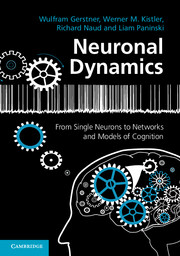Preface
Published online by Cambridge University Press: 05 August 2014
Summary
This textbook for advanced undergraduate and beginning graduate students provides a systematic introduction into the fields of neuron modeling, neuronal dynamics, neural coding, and neural networks. It can be used as a text for introductory courses on Computational and Theoretical Neuroscience or as main text for a more focused course on Neural Dynamics and Neural Modeling at the graduate level. The book is also a useful resource for researchers and students who want to learn how different models of neurons and descriptions of neural activity are related to each other.
All mathematical concepts are introduced the pedestrian way: step by step. All chapters are richly illustrated by figures and worked examples. Each chapter closes with a short summary and a series of mathematical Exercises. On the authors' webpage Python source code is provided for numerical simulations that illustrate the main ideas and models of the chapter (http://lcn.epfl.ch/~gerstner/NeuronalDynamics.html).
The book is organized into four parts with a total of 20 chapters. Part I provides a general introduction to the foundations of computational neuroscience and its mathematical tools. It covers classic material such as the Hodgkin–Huxley model, ion channels and dendrites, or phase plane analysis of two-dimensional systems of differential equations. A special focus is put on the firing threshold for the generation of action potentials, in the Hodgkin–Huxley models, as well as in reduced two-dimensional neuron models such as the Morris–Lecar model.
- Type
- Chapter
- Information
- Neuronal DynamicsFrom Single Neurons to Networks and Models of Cognition, pp. ix - xiiPublisher: Cambridge University PressPrint publication year: 2014
- 2
- Cited by

